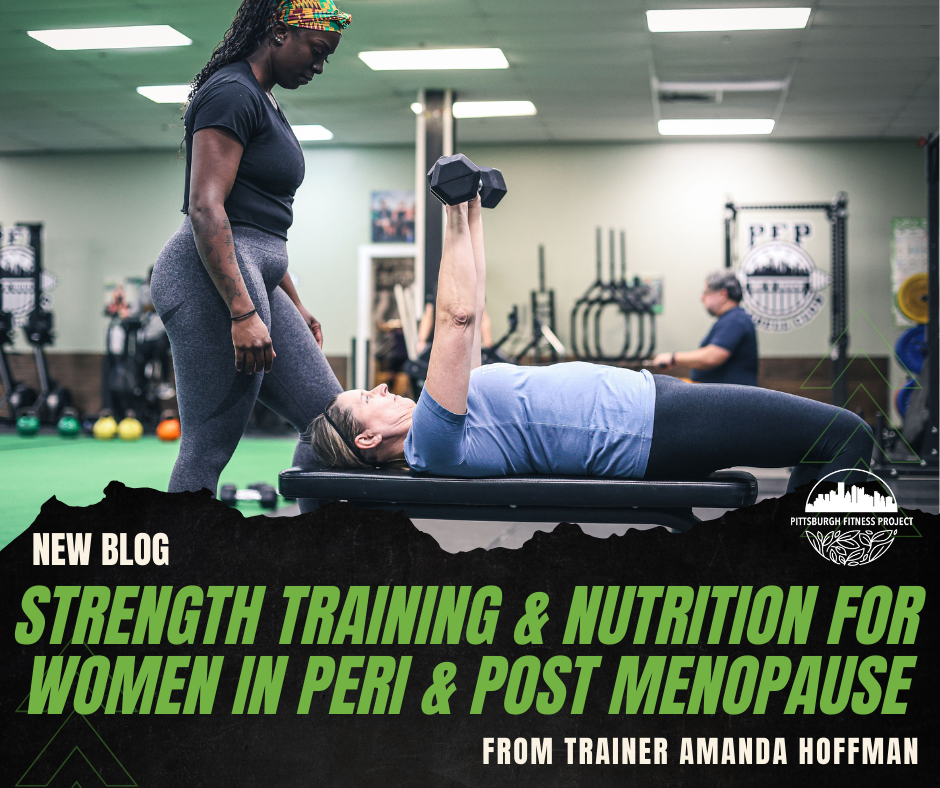STRENGTH TRAINING & NUTRITION FOR WOMEN IN PERI & POST MENOPAUSE
Research shows that the perimenopausal years (typically in your late 30s to early 50s) are the years with the most pronounced shifts in body composition: increased fat mass, reduced muscle mass, and elevated abdominal. The 30-50 age window is an ideal time to proactively work to build muscle and strength through nutrition and training to minimize changes and optimize metabolism.
After menopause (defined as 12 months without a menstrual cycle), our female hormones (estrogen and progesterone) remain consistently low. During these years it becomes harder to build and maintain lean muscle mass, more likely to gain abdominal fat, and have an increased risk for osteoporosis.
The problem is not that we are not always taught this, so we don’t always know what we should be doing to counter these declines. As if we needed anymore barriers, most research in health and fitness is done on men. Here’s what research on women of this age group recommends:
1. Lift Heavy
Research recommends heavy resistance training as the foundation of perimenopausal exercise.
Aim for 3 full-body sessions per week
Use compound movements (squats, deadlifts, lunges, presses, rows)
Work at 3–5 sets of ≤6 reps, leaving 2–3 reps in the tank
Focus on building a foundation first, but then don’t be afraid to add load.
Unilateral exercises: stability declines post-menopause; unilateral variations will help to reduce fall risk.
2. Include Power & Plyometrics
Strength isa great start, but power matters too. The ability for our body’s to move quickly and produce power declines faster with age and is critical for fall prevention and functional independence.
Incorporate plyometric or jump training 2-3 times a week
Begin slowly and with low-impact variations, like small hops or band-supported jumps
These drills also support bone density, improve metabolic function, and can help with strength gain
Quick change‑of‑direction drills will help to maintain bone density and reaction time
3. Sprint Interval Training
Long, moderate-intensity steady-state workouts (e.g., Zone 2 cardio) are often less effective for women in perimenopause—and may elevate cortisol without metabolic benefit. Instead, try short, intense efforts:
Sprint interval training: all‑out bursts of 10–30 seconds, followed by ~1–3 minutes recovery, with 5–10 reps per session
You don’t have to run – you can sprint on a bike, rower, ski erg, or even in the pool
SIT is more intentional than your standard “HIIT classes”. You don’t need a lot of it, but it has to be done well to be effective
Can help reduce fat, support metabolism, improve your ability to do work as well as recover faster
4. Focus on Getting Enough Protein and Carbs
Muscles need protein to stimulate repair and growth
Research supports ~1.8–2.3 g protein per kilogram of body weight daily (about 30-40g per meal plus 1-2 protein-rich snacks)
Pre-workout: consume 10-15g protein AND carb about 30-60 minutes before training. Avoid training fasted.
Post-workout: consume 35–40 g high-quality protein within 30–45 minutes of training
Why Follow This Approach?
Preserves lean mass and metabolism during hormonal changes
Supports bone health, which reduces fall and fracture risk
Improves insulin sensitivity and fat utilization, leading to abdominal fat loss
Counters cortisol spikes from moderate steady-state sessions with more targeted, efficient intensity
Strength and power training is about aging with resilience, function, and independence
Lifting heavy isn’t optional; it’s required for maintaining a high quality of life as we age
Get started training with our small group, Golden Girls, created for women 60+. Book a fitness assessment to learn more and get started training.
References:
A selection of original research and commentary by Dr. Stacy Sims, with guiding insights from her blog posts, interviews, and the Stanford longevity team.

